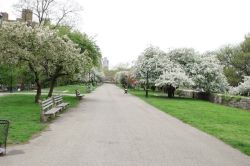Riverside Park
Dinosaur Playground
Dinosaurs were the largest animals ever to walk the earth, and they disappeared about 70 million years ago. The cause of their extinction remains a scientific mystery. Current theories suggest a sudden, catastrophic global cooling caused by gas thrown into the air by either a comet or an asteroid colliding with the planet, or by heavy volcanic activity. With the sun obscured, the climate cooled and effected habitat changes too drastic for the dinosaurs to survive.
The first dinosaur bones were discovered in Europe in the 1820s. Although scientists originally thought they were giant reptiles, many now believe dinosaurs are more closely related to birds. Dinosaurs laid eggs, as do both reptiles and birds, but there is an ongoing debate as to whether dinosaurs were warm blooded, like birds, or cold blooded, like reptiles.
This playground is home to two fiberglass dinosaurs, a triceratops and a hadrosaur. Both were plant eaters and lived in North America near the end of the Cretaceous period, which lasted from about 136 to 65 million years ago. These were the proverbial “last days of the dinosaurs,” as various species of the great beasts from T-Rex to velociraptor began to die out. It was also, however, an age that ushered in the first flowering plants, insects, and small mammal species that still exist today.
The first of the dinosaurs represented in this park is the triceratops, noted for the armor plating around its head and its three horns. With a pair of long (about three and a-half feet) horns above each eye and a shorter horn on its nose, the triceratops stood about eight feet tall and twenty feet long, weighing about eight tons.
The second fiberglass dinosaur is a hadrosaur, generally called a duckbill dinosaur or maiasaur. These creatures appear to have spent much time in the water, based on the webbing found on the feet of some fossils. Standing about 18 feet tall, the hadrosaur measured 40 feet from head to tail and weighed between 3 and 4 tons. Its cheeks contained small tooth-like structures, perhaps as many as 2,000, which formed surfaces to grind hard food.
In addition to the dinosaur sculptures, the playground includes swings for toddlers and older children, a spray shower, two sandboxes, and climbing equipment with safety surfacing. Towering London planetrees (Platanus x acerifolia) shade the playground and a stone public restroom stands at its southern end. The public restroom was built between 1934 and 1937 as part of the West Side Improvement Project that added this playground to Riverside Park. Riverside Park, as one of eight officially designated scenic landmarks in New York City, offers welcome relief from the bustle of the city and wonderful views of the Hudson River and New Jersey.
Check out your park's Vital Signs
Clean & Safe
Green & Resilient
Empowered & Engaged Users
Share your feedback or learn more about how this park is part of a
Vital Park System

Know Before You Go
Due to construction, as of September 23, 2024, Cherry Walk at Riverside Park is temporarily closed between West 100th Street and St. Clair Place (West 125th St). Please view our Temporary Greenway Detour map for an alternative route.
Anticipated Completion: Spring 2025
Related inquiries may be sent to boatbasin@parks.nyc.gov
Related inquiries may be sent to boatbasin@parks.nyc.gov


